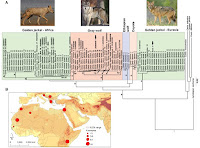The Borophagine, or 'Bone-crushing', Dogs were a distinctive group of Canids that lived in North America from the Oligocene till the Pliocene. The earliest members of the group were small and Fox-like, but they rapidly developed into larger animals with powerful enlarged jaws similar to those of modern Hyenas, and thought to be indicative of a similar durophagous (bone-crushing) diet.
In a paper published in the Journal of Paleontology on 9 May 2016, Steven Jasinski of the Paleontology and Geology Section at the State Museum of Pennsylvania, the Department of Earth and Environmental Science at the University of Pennsylvania, and the Don Sundquist Center of Excellence in Paleontology, and Steven Wallace, also of the Don Sundquist Center of Excellence in Paleontology, and also of the Department of Geosciences at East Tennessee State University, describe a new species of Borophagine Dog from the Middle Miocene Choptank Formation of Calvert County, Maryland.
The new species is placed in the genus Cynarctus, and given the specific name wangi, in honour of Xiaoming Wang of the Natural History Museum of Los Angelese County for his work on Borophagines and Canids in general. The species is described from a single tooth, a second right molar; individual teeth are often considered distinctive enough for species identification in Mammals, and describing species from individual teeth is not unusual. In the case of Borophagine Dogs, which have enlarged, flattened teeth compared to other Canids, the genus Cynarctus can be distinguished by having particularly large, flat, second molars; so a notably large and flat Cynarctus second molar distinctive enough to be excluded from any currently described species in the genus can be described as a new species with a degree of confidence.
M2 of Cynarctus wangi. (A) Occlusal view. (B) Illustration of occlusal view. c, cleft; hyp, hypocone; labc, labial (external) cingulum; linc, lingual (internal) cingulum; met, metacone; mts, metastyle; mtl, metaconule; par, paracone; posc, posterior (distal) cingulum; prs. parastyle; pro. protocone. Scale bar is 1 cm. Jasinski & Wallace (2016).
See also...
 Photogrammetry as a tool in Morphometric Analysis. Morphometric
analysis is a tool used by palaeontologists, archaeologists,
anthropologists and forensic pathologists to analyse and...
Photogrammetry as a tool in Morphometric Analysis. Morphometric
analysis is a tool used by palaeontologists, archaeologists,
anthropologists and forensic pathologists to analyse and... Lycaon pictus: African Hunting Dogs adopt different hunting stratergies in different environments. African Hunting Dogs, Lycaon pictus, are highly social pack
hunting Canids found across much of Sub-Saharan Africa, though they have
been heavily persecuted by Humans in many areas, and now have...
Lycaon pictus: African Hunting Dogs adopt different hunting stratergies in different environments. African Hunting Dogs, Lycaon pictus, are highly social pack
hunting Canids found across much of Sub-Saharan Africa, though they have
been heavily persecuted by Humans in many areas, and now have... Cryptic diversity: A new species of Wolf from Africa. Cryptic species are species which
closely resemble other species and which can only be separated by careful
anatomical examination or even genetic analysis. In recent years the widespread
application of...
Cryptic diversity: A new species of Wolf from Africa. Cryptic species are species which
closely resemble other species and which can only be separated by careful
anatomical examination or even genetic analysis. In recent years the widespread
application of...
Follow Sciency Thoughts on Facebook.

